Extraterrestial Life
Have we found aliens out there? Find out how the scientist are searching for life outside our planet.
Execute an astrobiological experiment with green algae using the satellite simulator.
Jump to Satellite Simulator activity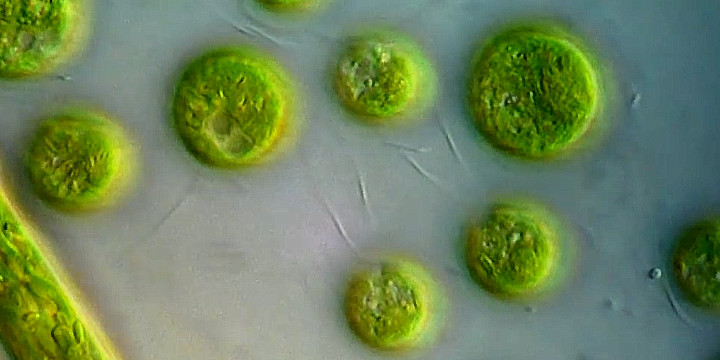
Many humans around the world have wondered if we are alone in this universe. For thousands of years, we looked up at the night sky and asked if life exists outside our planet Earth. But before that, we should be asking a simpler question:
What is life?
A few thousand years ago, this question seemed to be easier to answer because we didn’t know as much as we know today about the “microscopic world” and there was a clear separation. With the invention of the microscope, we discovered that life flourishes at smaller scales and there are many different living organisms there. Interestingly, all life on Earth can be traced back to the Last Universal Common Ancestor (LUCA) of all living organisms.
The current definition of life is "an organism with an open system that maintain homeostasis, is composed of cells, has a life cycle, can grow, adapt to its environment, respond to stimuli, reproduce and evolve". However, this definition leaves virus out because they lack characteristics such as a cell membrane, metabolism and the ability to grow or respond to their environments.

Earth is still the only place in the universe known to harbor life forms. Humans have sent space probes to other celestial objects in the solar system but contamination from Earth was minimized by sterilizing the spacecraft. It not impossible that microscopic life could have been transferred between celestial objects in the universe from comets and/or asteroids, this is known as the panspermia hypotheses.
According to many astrobiologists, in order for life to arise and survive, it must be found on a planet or moon within the habitable zone of the star. The habitable zone is where the temperature is just right: not too hot and not too cold for liquid water to exist. In 2009, the Kepler mission was launched to look for planets in the habitable zone of other stars in the milky way and has found many planets.
Recently, some scientists have considered expanding the definition of the habitable zone in our solar system given the fact that we discovered that some of Jupiter’s moons are covered in ice with underground oceans of water that can potentially sustain life. Meanwhile, here on Earth, “extremophiles” were found living in extreme conditions like next to underwater volcano plumes where there is barely any light, in underground caves, and also in the poles where the weather is extremely cold.
Life on Earth can be found in essentially all locations where water is present, even in places where there is no sun light. One of the moons of Jupiter, Europa, is believed to have a large quantity of liquid water, in fact it is believed to have more liquid water than here on Earth. This makes Europa an excellent candidate in the search for life elsewhere in the Solar System.
The first missions to Europa were the Voyager and Galileo spacecraft missions which took impressive photographs of its icy surface. Until today, we haven't landed on Europa nor explored its deep ocean of water. The biggest challenge for exploring its ocean is reaching the liquid water, which lies beneath a crust of frozen ice. We would need to send a robot with drilling equipment that can overcome these challenges for the search of life in Europa’s dark and ice-covered ocean.
Two space missions are currently in preparation for collecting more information about Europa, one is JUpiter ICy moons Explorer, also known as the JUICE mission, a mission from the European Space Agency and the other space mission is Europa Clipper from NASA. Additionally, there are on-going studies for a “Europa Lander”, a future mission with the objective of actually landing on the surface of Europa.
The discovery of Europa’s ocean has raised many questions among scientists which have speculated about the existence of life there. Looking at its pictures, we can see an icy surface with some red pigmentation scattered all over it. We also know that Europa has a very thin atmosphere composed primarily of oxygen.
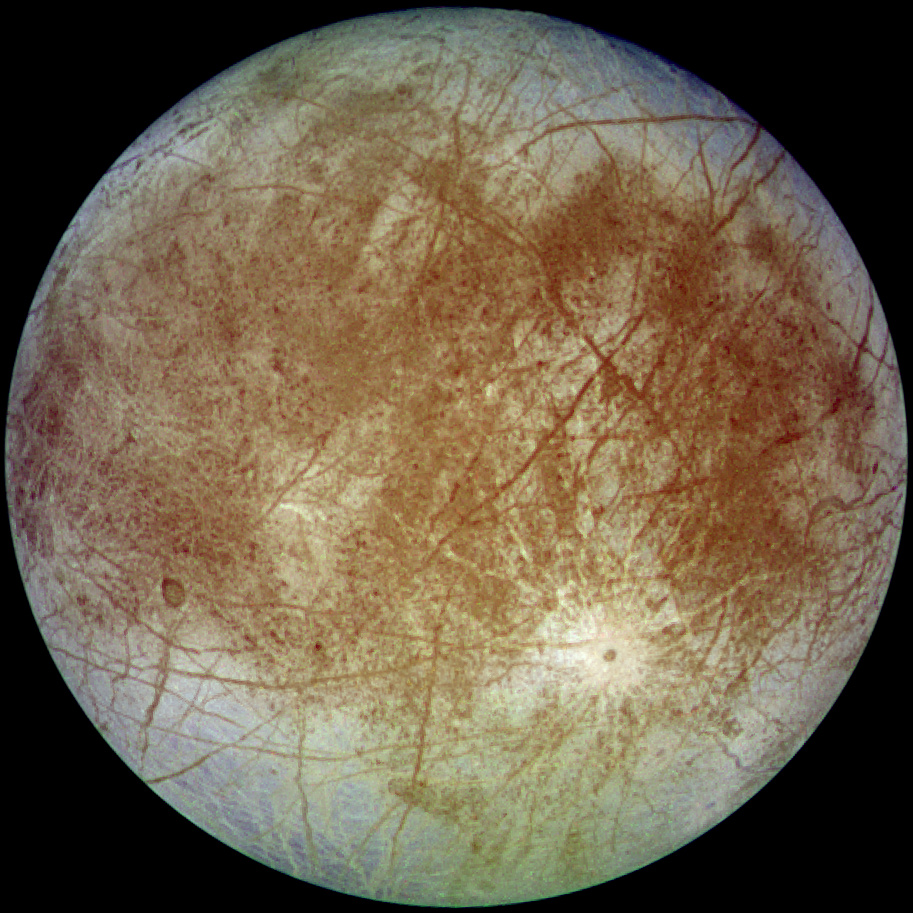
There are living organisms living in ice here on Earth. The “watermelon snow” phenomenon makes the snow look red and it is caused by lichen and/or algae such as the “Chlamydomonas nivalis”. On an experiment done by the European Space Agency, lichen was taken to the International Space Station and exposed to outer space for 14 days. The experiment demonstrated that lichen was able to survive the harsh environment of space.
The composition of the "red stuff" that we see on its surface is not entirely understood. Most likely it is just hydrated salts like magnesium sulfates. But what if it is life? Maybe we have already found life in the solar system but we were just not able to recognize it from the images.
So far, there is no evidence that life exists on Europa, but Europa has emerged as one of the most likely locations in the Solar System for potential habitability.
Here on Earth, non-intelligent life is more common than intelligent life. Intelligence is defined as the ability to acquire and apply knowledge and skills. The Homo Sapiens is the most intelligent animal on Earth and because of that, it was able to colonize all continents and to consciously reach another celestial body by combining the knowledge from years of research.
Is life a precondition to sapience? For thousands of years we assumed that we were “special” and only humans were intelligent. However, with the recent advancements in computer technology, Artificial Intelligence (AI) might one day become as smart or even smarter than humans. In this universe, the biological form might not be the most efficient way to achieve intelligence, humans still make many decisions based on their emotional feelings, need water and energy in form of food, and also need to rest for about one third of a day, every single day!
The technological singularity is the hypothesis that the invention of artificial superintelligence will abruptly trigger a runaway technological growth, resulting in very fast changes to human civilization that cannot be understood by us, humans. Intelligence explosion is a possible outcome of humanity building artificial general intelligence, as it would be capable of recursive self-improvement leading to rapid emergence of artificial superintelligence, the limits of which are unknown, at the time of the technological singularity.
The Berkeley Search for Extraterrestrial Intelligence (SETI) Research Center created the SETI@home project which is an Internet-based public volunteer computing project with the purpose to analyze radio signals, searching for signs of extraterrestrial intelligence. It searches for possible evidence of radio transmissions from extraterrestrial intelligence using observational data from the Arecibo radio telescope and the Green Bank Telescope. Until today, no evidence signals for extraterrestrial intelligence were found.
According to Wikipedia, Astrobiology is "an interdisciplinary scientific field concerned with the origins, early evolution, distribution, and future of life in the universe".
Humans started to launch animals into space in late 1940s and 1950s for scientific purposes. The vital signs of the animals were being measured and the equipment on-board was being perfected to allow humans to be eventually launched. Back then, the outer space was an unknown environment and so we had to experiment with other living animals to learn more.
On Earth we are protected from much of the electromagnetic radiation that comes from space by Earth’s atmosphere and magnetic field. As we rise through the atmosphere, climb a high mountain, take a plane flight, go to the International Space Station, or to the Moon, we rapidly lose the protection of the atmosphere.
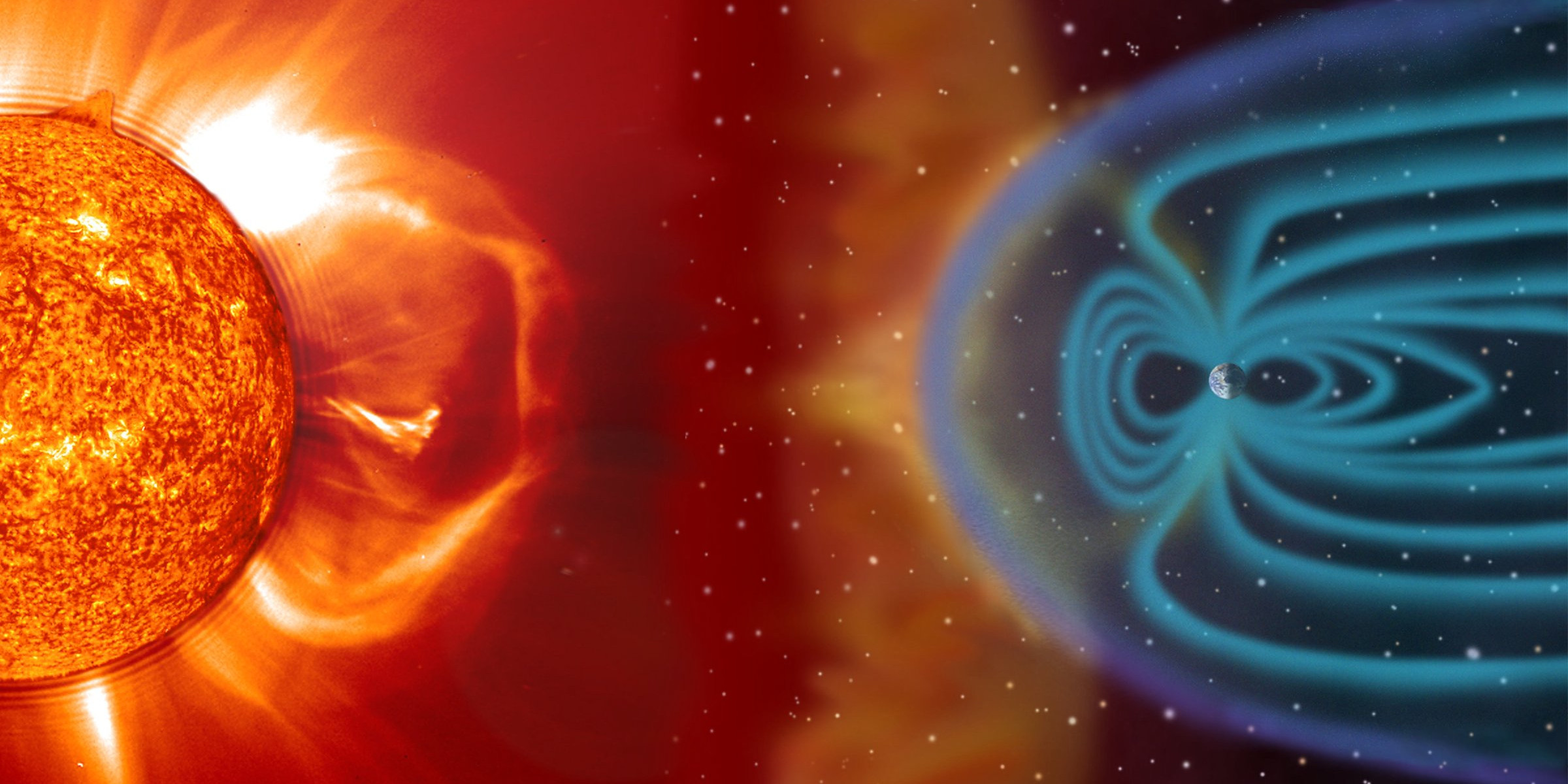
Unlike in the movies, being exposed to radiation does not give you super powers. In real life, you are much more likely to get cancer from radiation exposure than to become Hulk! Because of this fact, scientists have done extensive research on what happens to biological material when it is exposed to the harsh radiation experienced in space.
Many of the scientific radiation experiments can be done in laboratory facilities on ground, but sometimes, scientists also like to send experiments to space as it gives more accurate results.
As mentioned above, the “watermelon snow” makes the snow look red and is caused by algae like the “Chlamydomonas nivalis”. Although unlikely, a potential explanation for the red pigment scattered on the ice of Europa could be the existence of a similar algae to Earth's “Chlamydomonas nivalis”. Our satellite simulator includes samples that contain two living organisms, the Chlamydomonas and the Euglena viridis. Can they survive in space?
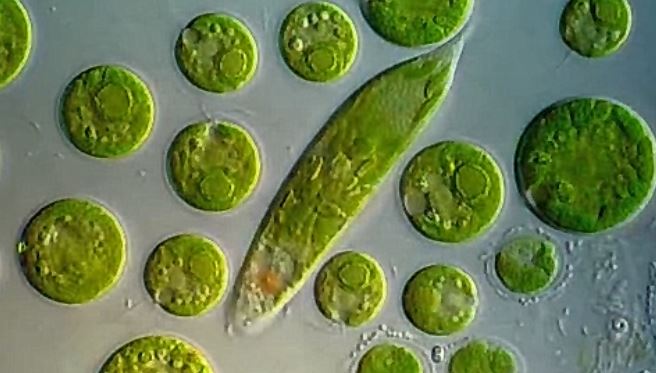
The Chlamydomonas have a round shape while the Euglena viridis have an elongated shape. You can distinguish the two different organisms in the picture above which is a photograph of one of our samples. Notice that the Chlamydomonas does not look red because they are not the actual “Chlamydomonas nivalis” existing in the snow however they are closely-related to them.
In our experiment, we want to test the following hypotheses:
“Can Chlamydomonas and Euglena viridis survive 1 hour in space?”
To test this hypothesis, we will expose organisms to space radiation and verify if they are still alive after exposure. The satellite simulator includes two samples: Sample A, and Sample B.
Sample A: is the control sample. We can use this sample to visually compare it with the Sample B. Scientists always use a control sample to make sure that there were no other external factors influencing the outcome of the experiment.
Sample B: is the sample that will be exposed to space.
Our satellite simulator includes a digital microscope that can record a video of the samples. The recording should be done after the exposure to space in order to determine if our hypotheses holds true.
The procedure of the experiment is the following:
Now let’s expose some biological samples to outer space!
1. Open the AstroMissions App and go to the “Satellite Simulator” tab. Press “Launch!”:
After pressing the button, the satellite simulator will start and a set of instruments will be displayed on the right side.
2. Press the “Astrobiology Experiment” instrument icon in order to start it:

The “Astrobiology Experiment” instrument will initialize. The “Console View” will be presented during initialization and it will switch automatically to the “Services View” after initialization. In this instrument, we can control the biological samples and test the hypotheses.
3. Check out the Parameters Dashboard flashing:
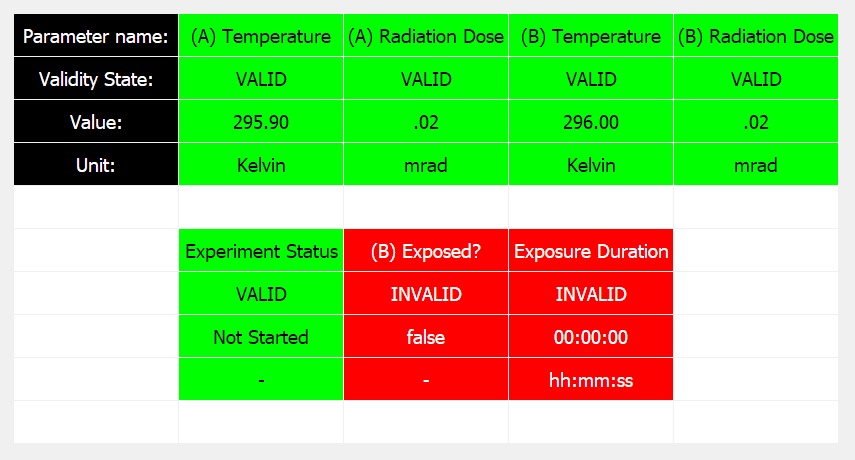
Our satellite includes sensors for measuring the Temperature and the Radiation Dose of both sample A and sample B. These parameters can be visualized on the top part of the Parameters Dashboard. The temperature of the samples will be kept constant by the satellite at approximately 296 Kelvin (this is about 23°C or 73°F).
The official SI unit of radiation is the Gray (Gy) but it is more common to use the Rad (radiation absorbed dose): 1 rad = 0.01 Gy = 0.01 J/kg of material. In our satellite simulator, we will measure the radiation dose in mrad which is millirad: 1000 mrad = 1 rad
Notice the two red parameters: The first one “(B) Exposed?” is showing if the sample B is exposed to outer space and will switch to green when the sample is exposed. The “Exposure Duration” will change to green when the experiment is concluded.
4. Go to the Action panel and execute Expose Sample B:
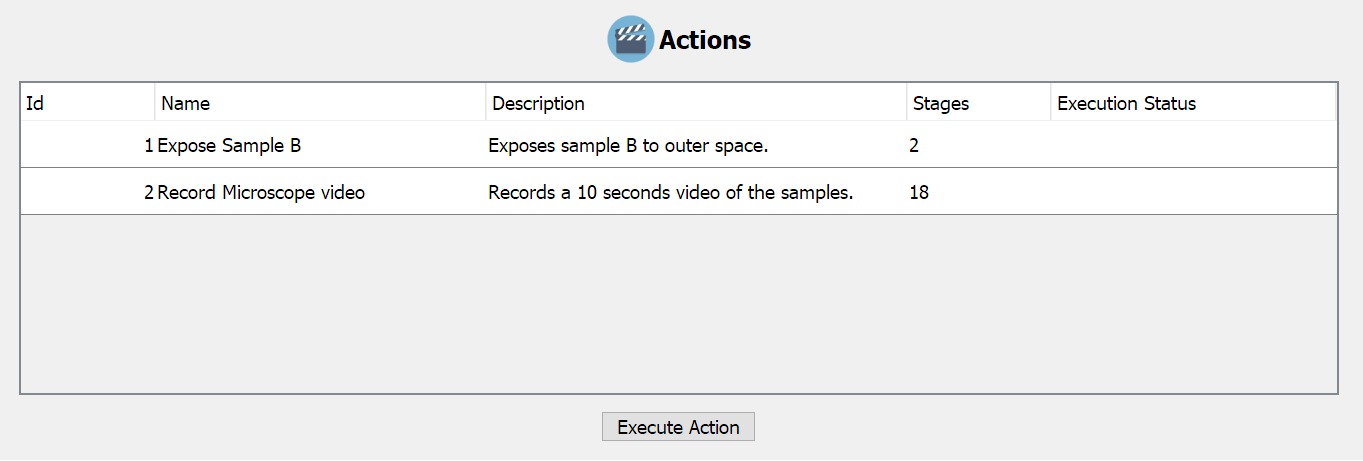
Sample B is now exposed to outer space. You can see that the “Experiment Status” changed to “On-going”. The experiment takes one hour to complete, you can see the duration of the experiment on the red flashing parameter “Exposure Duration”.
Once the time reaches 1 hour, the sample will be automatically returned to the inside of the satellite and will no longer be exposed to space.
5. Check out the Parameters Dashboard flashing:

The “(B) Exposed?” parameter is now flashing green because the experiment is exposed to the radiation in outer space. The radiation in Low Earth Orbit (LEO) is higher than on ground. After exposing sample B, we can observe that the “(B) Radiation Dose” parameter will start to increase.
The “Expose Duration” parameter is showing for how long the experiment is running. This value will keep increasing as the time goes by. Remember, the total duration of the experiment is one hour and this will flash green as soon as the experiment ends.
6. Speed-up the simulation by clicking on the “View Satellite Controller” button on the bottom. Then change the Time Factor to 50 and press the Set Factor button:
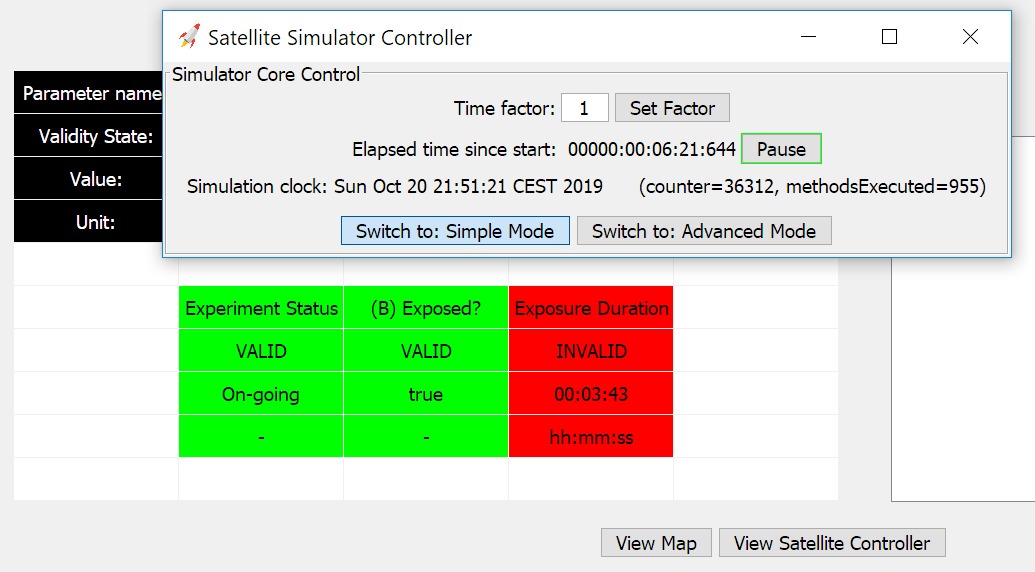
The simulation speed is now running 50 times faster. The Exposure Duration parameter will start flashing green once it reaches one hour. As soon as that happens, the experiment is concluded and Sample B will be automatically returned to the inside of the satellite.

7. Record a video from the digital microscope by selecting the Record Microscope video action and click on the “Execute Action” button:
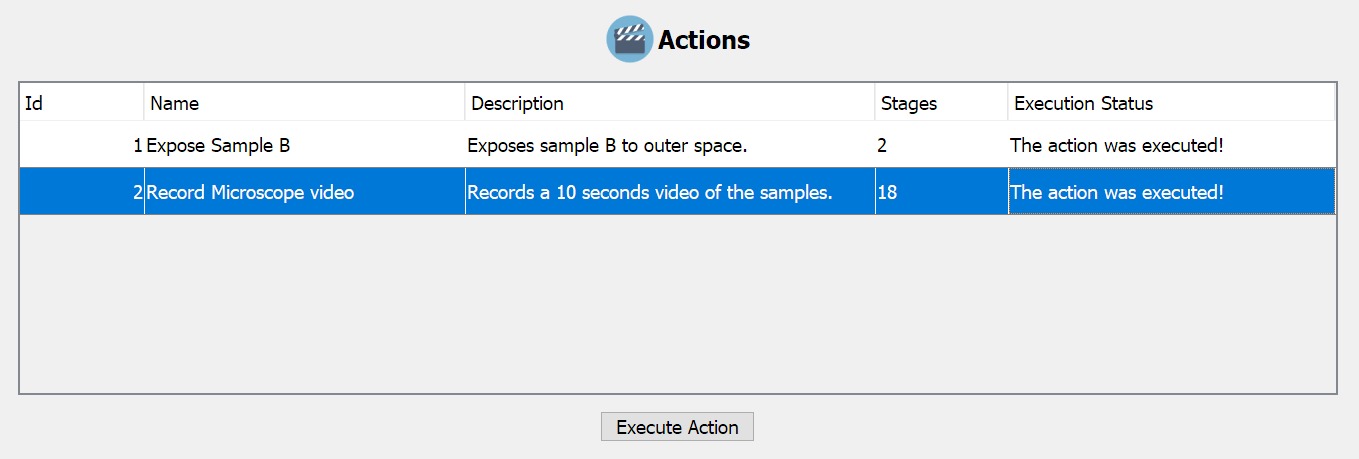
When the action is concluded, a video will appear in the Multimedia Inbox. The digital microscope has a 1000x magnification capability which allows the visualization of the Chlamydomonas and Euglena viridis on both samples.
8. Click on the Microscope Video icon in the Multimedia Inbox to play and analyze the samples:

Now compare the sample A and sample B!
Are the organisms on sample B alive?
The Chlamydomonas have 2 flagella for locomotion. If you look closely, you can see these in the outside part around the cell. The Chlamydomonas used the flagella to move around which makes it easy to verify if they are alive.
The damage threshold for biological matter is 10^1 - 10^2 rad according to the data collected by scientists. The radiation dose that sample B was exposed to is just a fraction of the threshold. To reach the threshold, we would have to expose sample B for a longer duration or at an higher altitude where the amount of radiation would be higher.
Please notice that even though the radiation might not have killed the organism, it might have damaged its DNA genetic material which might only affect the next generation of cells and therefore impede the organisms' reproduction cycle. The experiment should have also checked the survival rate of the “child” cells, to determine if the radiation interfered in its replication.
If you are wondering "Where Are All The Aliens?" check this video:
Click here to recommend AstroMissions to your teacher and friends!